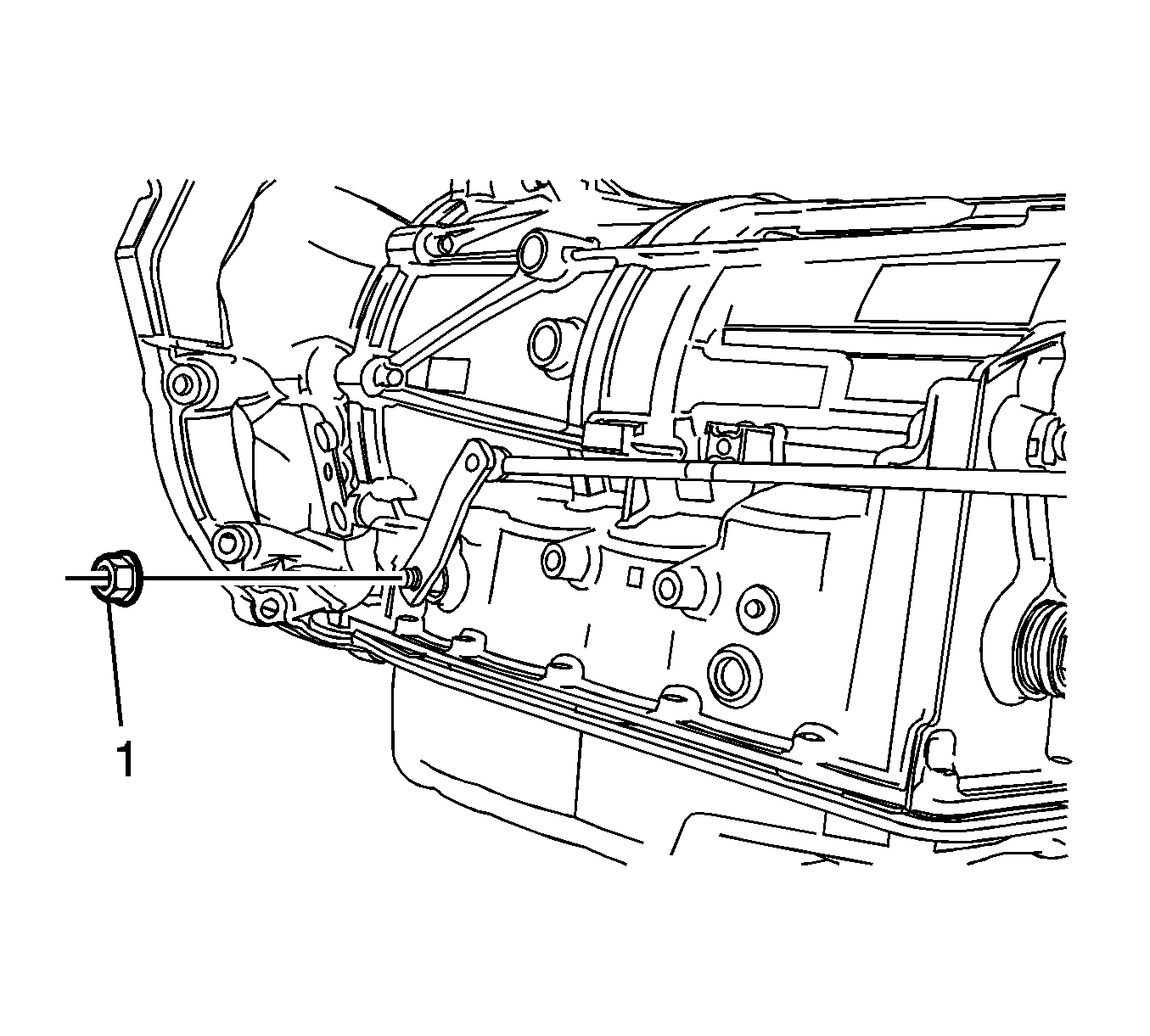Note: NEW cooler pipe O-rings and torque converter bolts will be required each time the transmission is removed and installed.
Removal Procedure
- Remove the exhaust system. Refer to Exhaust Muffler with Resonator, Exhaust, and Tail Pipe Replacement
- Remove the catalytic converters. Refer to Catalytic Converter Replacement - Left Side and Catalytic Converter Replacement - Right Side
- Remove the propeller shaft. Refer to Propeller Shaft Replacement
- Disconnect the shift linkage from the transmission.
- Remove the transmission vent hose from the retaining clips (6) on the transmission support.
- Disconnect the transmission wiring harness connector (4) from the transmission by releasing the locking mechanism and rotating the latch counterclockwise.
- Remove the wiring harness retainers (1) from the transmission.
- Remove the oxygen sensor wiring harness connector (2) from the transmission.
- Place an oil drain pan under the transmission fluid cooler pipes.
- Remove the transmission fluid cooler pipes (1) from the transmission, and position aside.
- Remove and discard the O-rings. Do NOT reuse the O-rings.
- Plug the open outlet ports to prevent fluid loss and contamination.
- Remove the transmission close out plug (1).
- Mark the torque converter to flexplate/flywheel orientation to ensure proper realignment.
- Remove the starter motor. Refer to Starter Replacement
- Repeat the following steps for all torque converter bolts (1):
- Support the transmission with a suitable transmission jack.
- Remove the transmission support. Refer to Transmission Mount Replacement
- Slightly lower the transmission to gain access to the upper transmission retaining bolts.
- Disconnect the transmission vent hose (4) from the transmission vent pipe (1).
- Remove the wiring harness retainers (2) from the transmission.
- Position the transmission wiring harness (1) and vent tube out of the way.
- Remove the transmission mounting bolts (1-6).
- Remove the remaining transmission bolts from the transmission.
- Pull the transmission free from the engine dowels.
- Carefully lower the transmission from the vehicle.
- Flush the transmission oil cooler if necessary.






| 16.1. | Rotate the harmonic balancer center bolt clockwise ONLY, in order to align the torque converter bolt with the access hole. |
| 16.2. | Remove and discard the torque converter bolts. |



Note: Ensure clearance is maintained between the transmission and the following:
• The wiring harness • The vent tube • The cooler pipes
Installation Procedure
- Using the transmission jack, carefully raise the transmission to the engine.
- Align the transmission with the engine dowels.
- Install the transmission mounting bolts and tighten to 50 N·m (37 lb ft).
- Position the engine wiring harness (1) to the original location.
- Install the wiring harness retainers (2) to the transmission.
- Connect the transmission vent hose (4) to the transmission vent pipe (1).
- Raise the transmission to the installed position.
- Install the transmission support. Refer to Transmission Mount Replacement
- Remove the jack from under the transmission.
- Align the torque converter to flexplate/flywheel orientation marks made during the removal procedure.
- Complete the following steps for all torque converter bolts (1):
- Install the starter motor. Refer to Starter Replacement
- Install the transmission close out plug (1).
- Place NEW O-rings over the transmission fluid cooler pipes.
- Install the transmission fluid cooler pipes (1) to the transmission.
- Install the oxygen sensor wiring harness connector (2) to the transmission.
- Install the wiring harness retainers (1) to the transmission.
- Connect the transmission wiring harness connector (5) to the transmission by rotating the locking latch clockwise.
- Install the transmission vent hose to the retaining clips (6) on the transmission support.
- Install the shift linkage to the transmission. Refer to Shift Control Linkage Replacement
- Install the propeller shaft. Refer to Propeller Shaft Replacement
- Install the catalytic converters. Refer to Catalytic Converter Replacement - Left Side and Catalytic Converter Replacement - Right Side
- Install the exhaust system. Refer to Exhaust Muffler with Resonator, Exhaust, and Tail Pipe Replacement
- Lower the vehicle.
- Check the transmission fluid level and fill if necessary.
- Adjust the shift control linkage. Refer to Shift Control Linkage Adjustment
Note: Ensure clearance is maintained between the transmission and the following:
• The wiring harness • The vent tube • The cooler pipes

Caution: Refer to Fastener Caution in the Preface section.



Note: Torque converter bolts are self locking and must be replaced with NEW torque converter bolts every time the bolts are removed.
| 11.1. | Rotate the harmonic balancer center bolt clockwise ONLY, in order to align the torque converter bolt holes in the flexplate/flywheel with the access hole in the engine block. |
| 11.2. | To aid in alignment of the torque converter to the flexplate/flywheel. Install all NEW torque converter bolts before fully tightening to 65 N·m (48 lb ft). |





Transmission Final Test and Inspection
Complete the following procedure after the transmission is installed in the vehicle:
- With the ignition OFF or disconnected, crank the engine several times. Listen for any unusual noises or evidence that any parts are binding.
- Start the engine and listen for abnormal conditions.
- While the engine continues to idle, raise and support the vehicle.
- Inspect for fluid leaks while the engine is idling.
- Perform a final inspection for the proper fluid level.
- Lower the vehicle.
- Calibrate the transmission control module (TCM).
- Reset the TAP values. Refer to Service Fast Learn Adapts
- Road test the vehicle. Refer to Road Test
Note: It is recommended that transmission adaptive pressure (TAP) information be reset.
Resetting the TAP values using a scan tool will erase all learned values in all cells. As a result, The ECM, PCM or TCM will need to relearn TAP values. Transmission performance may be affected as new TAP values are learned.